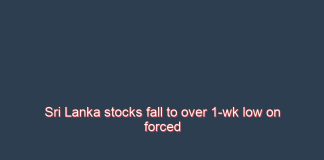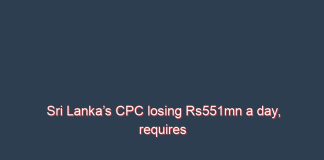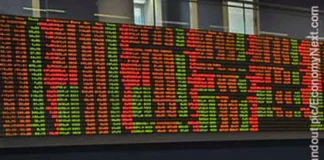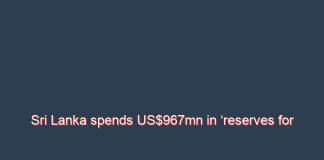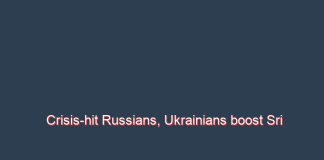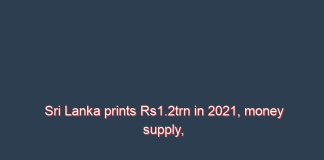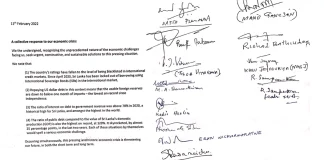Sri Lanka stocks fall to over 1-wk low on forced sales;...
ECONOMYNEXT – Sri Lanka’s stock index fell 1.77 percent on Friday (18) to its lowest in more than one week low with investors were forced to sell their stake to settle broker credit amid economic concerns, brokers said.
Sri Lanka’s CPC losing Rs551mn a day, requires price hike: Minister
ECONOMYNEXT – Sri Lanka’s state-run Ceylon Petroleum Corporation has lost 83 billion rupees in 2021, and is running a 551 million rupee a day loss in February 2022 amid rising global oil prices and domestic taxes, Petroleum Minister Udaya Gammanpila said.
The CPC was now making a loss 551 million rupees a day, Minister Gammanpila said on February 18.
CPC had lost 83 billion rupees last year.
The CPC was making loss of 19 rupees on a litre of Petrol Octane 92 after taxes and 17 rupees on Petrol Octane 95.
The firm was losing 52 rupees from a litre of auto diesel and 35 rupees from super diesel.
On Kerosene it was losing 63 rupees.
Government taxes on Petrol 92 were 42 rupees a litre, on Petrol 95 64 rupees, diesel 17 rupees and super diesel 39 rupees.
Each day the CPC was paying 368 million rupees in taxes as the firm lost 551 million rupees.
The CPC had asked for a price hike or a tax cut as it cannot borrow any more.
“CPC can’t borrow any more loans from banks,” Gammanpila said.
“We have already borrowed 3.71 billion dollars so far. We can’t borrow dollars anymore
Finance ministry has to decide how much tax should be reduced. So far they have not informed. Even if the tax is reduced, we will have to increase the prices.”
The CPC, which has no dollar revenues, is forced to borrow by Sri Lanka’s Mercantilist policy-makers every time the central bank prints money and creates forex shortages.
The CPC is then forced to borrow dollars and get hit by a massive forex loss when the currency eventually collapses.
“We have not decided to increase prices yet,” Gammanpila said. “Some fuel retailers have created shortage expecting that we are going to increase the prices. We will only inform the price revision only after 10 pm.”
Sri Lanka is now in the throes of yet another currency crisis and Sri Lanka is now getting a 500 million dollar credit line from India instead of tightening monetary policy. Inflation is also running at 14.2 percent in the year to January 2021.
Sri Lanka has also not gone to the IMF, which generally asks for monetary tightening and a float of the currency to stop sterilized intervention or printing money after giving reserves for imports.
Minister Gammanpila said he supported an IMF program and most of the cabinet was also in favour. (Colombo/Feb18/2022)
Sri Lanka shares slip to one-week low amid forced selling
Roses dominate in Sri Lanka’s picked up valentine sales
Sri Lanka spends US$967mn in ‘reserves for imports’
ECONOMYNEXT – Sri Lanka has spent 967 million US dollars to give ‘reserves for imports’ in the past four months and strictly enforce a 200 to the US dollar peg on which credibility has been lost, official data shows.
In a functioning monetary regime, a pegged central bank does not give any ‘reserves for imports’ but collects a small amount of dollars from monthly inflows at a market interest rate by slowing credit and outflows to re-build or maintain reserves after repaying debt.
In the nine months to September the central bank bought about 228 million dollars net from transactions with commercial banks though total reserves continued to go down at the interest rates and domestic credit levels then prevailing due to debt repayments.
A substantial volume of foreign exchange was also ‘floating’ unofficially at the time with exporters giving dollars at round 220 to the US dollar by transferring to accounts of importers with a non-credible peg at 200 to the US dollar being declared.
Such sales do not change reserve money or require new money to be printed.
However with banks given strict instructions not to facilitate such deals, the central bank had to give more ‘reserves for imports’.
From October to January the central bank had given 967 million US dollars on a net basis to commercial banks in ‘reserves for import’.
Selling reserves for imports is a defence of the peg at 200 to the US dollar.
However when a central bank sells dollars to the market, reserve money shrinks. The central bank then has to print money to stop short term interest rates from going up.
The newly printing money then gives more rupee reserves for banks to give loans without deposits to customers and imports continue to go up.
By December monthly imports rose to 2.2 billion US dollars from 1.6 to 1.7 billion US dollars in earlier months.
From October to December the central bank 736 million dollars on a net basis to banks.
In the same period 262 billion rupees were printed. Monetary base also rose about 20 billion rupees.
The central bank is now printing money to offset or sterilize such reserve sales and also to give a subsidy to expat workers who are remitting money.
In an extraordinary development, there were calls made in Sri Lanka pressure the central bank to use ‘reserves for imports’, which analysts say is a call to printing money and worsen a sterilized intervention cycle.
In order to get out of a currency crisis the cycle of giving ‘reserves for imports’ has to be halted, usually through a float at a market interest rate.
Sri Lanka’s pegged exchange rate is currently broken and reserves. The peg is also under pressure from surrender requirement.
In January the central bank sold 407 million US dollars to the market and bought 176.8 million US dollars from banks.
Such reserve sales were last seen in the 2018 currency crisis. All of Sri Lanka’s past currency crises have intensified. (Colombo/Feb15/2022)
Crisis-hit Russians, Ukrainians boost Sri Lanka’s tourism recovery
ECONOMYNEXT – Foreign visitors from Russia and Ukraine, the two countries now threatening the world of an armed war amid escalated tension, helped Sri Lanka’s post-Covid-19 tourism recovery this year, the official government data showed on Monday (14).
Russians accounted for 18,044 or 15.8 percent of the total 113,670 holiday makers who visited Sri Lanka this year up to February 11, while Ukrainians accounted for 9,883 or 8.7 percent of the total visitors in the same period.
Russia has more than 100,000 troops massed near Ukraine, which is not part of the Atlantic military alliance, and Washington – while keeping open the diplomatic channels that have so far failed to ease the crisis – has repeatedly said an invasion is imminent, Reuters has reported on Monday.
“An analysis of Russian arrivals in the consecutive years reveals that it has almost exceeded the pre
pandemic levels as experienced in January 2019,” the state-run Sri Lanka Tourism Development Authority said in its January monthly report.
“This could be likely due to increased interest by Russian tour operators in alternative destinations to
Thailand and Goa with strict public health measures in place and the launching of direct flights to
Russia.”
The country saw an increase of Ukrainian and Russian travelers after a tourism revival projected
targeting those countries was launched in late 2020 by former Sri Lankan Ambassador to Russia
Udayanga Weeratunga.
Sri Lanka started direct flights between Sri Lanka and Russia from November last year following an agreement between Russia’s Aeroflot airline and Sri Lanka’s Civil Aviation authority.
The island nation, populour for its shallow beaches and diverse nature attracted 12.3 percent of the offshore visitors from both Russia and Ukraine in 2021 when it saw only a total of 194,495 tourists visited the country.
The SLTDA has targeted at least 1.1 million arrivals this year with a targeted average of
90,000 tourists per month.
Sri Lanka’s revenue from tourism hit 110.7 million US dollars in January this year compared to 2.3 million US dollars a year ago mainly due to lockdown in 2021.
The SLTDA has aimed to promote Sri Lanka as a destination for foreign weddings, meeting, nd conferences to boost the number of tourists in the country. (Colombo/Feb14/2022)
Lore of the Law and Other Memories
Sri Lanka prints Rs1.2trn in 2021, money supply, food prices up...
ECONOMYNEXT – Sri Lanka has printed 1.2 trillion rupees in 2021 most of which has flowed out of the country as a balance of payments deficit official data shows on top of 505 billion rupees printed in 2019 mostly to keep interest rates down.
Central bank credit to government grew to 2,093 billion rupees by December 2021 from 868.9 billion rupees a year earlier.
A part of the central bank credit to government including over 200 billion in July 2021 relates to foreign reserves appropriated to repay bonds, which did not create domestic inflation. However they prevented the monetary system from tightening and rates from rising.
In 2020 Sri Lanka printed 505.9 billion rupees based on official data, but the liquidity injected to the banking system was much higher. Money was injected also by a cut in the statutory reserve ratio. In a bizarre move the money was re-printed in September 2021.
BOP hit
In 2020 some of the money was printed to give Covid-19 re-finance.
In the way data is currently calculated in Sri Lanka, printed money remaining as excess liquidity in the system does not get captured as central bank credit until it disappears from the country as a BOP deficit. At the beginning of December 200 billion rupees of excess liquidity remained in the system.
A large part of the money in both years was printed came from yield controls imposed on Treasuries auctions, which caused them to fail and liquidity to be injected.
After August 2021 price controls were lifted and bond auctions were mostly successful.
However since then money is printed mostly to sterilize reserves given for imports. The central bank is also printing money for remittances.
The money boomerangs as import demand when the families of expat workers spend them and more reserves are lost as they new money is exchange for dollars via imports.
In 2021 Sri Lanka was hit by a balance of payments deficit of 2.3 billion rupees as the printed money was exchanged for monetary reserves.
In 2021, the BOP deficit was 3.9 billion US dollars.
Related
Sri Lanka BOP deficit hits record US$3.9bn in 2021 amid money printing
In September 2021, a statutory reserve ratio was hiked and the entire money was printed in a bizarre move.
Inflation
In the two years reserve money has grown 40 percent. Broad money had also grown 40 percent despite weak economic growth, creating conditions for rapid price rises.
While liquidity injections hit the balance of payments fast (4 to 6 weeks) with imported goods coming in to fill domestic demand.
Persistent money printing to keep rates down leads to growth in credit and broad money, triggering domestic inflation.
When rates are kept down artificially, money also go to long term assets, driving up a speculative bubble. People may also buy assets fearing inflation or currency depreciation. Capital flight may also take place.
In most countries broad money growth turns in to domestic inflation after 12 to 24 months. Similar problems had been seen in countries like the US.
In Sri Lanka the broader consumer price index, which also includes services which rises slowly, has risen 17 percent over the two years.
Food prices have risen 40 percent.
Sri Lanka exported and imported goods also rise when the US prints money, driving up commodity prices. Traded goods respond quicker to loose policy.
Related
US inflation likely to stay high in 2022, 2023 even if Fed tightens now: Steve Hanke
Anchor Conflicts
Sri Lanka’s monetary policy deteriorated rapidly after the end of a 30-year war and accelerated after the retirement of Deputy Governor W A Wijewardena, analysts have said.
Sri Lanka stated following ‘flexible’ inflation targeting, a highly discretionary domestic anchor, despite having a foreign reserve collecting highly unstable peg with the US dollar called a ‘flexible’ exchange rate as an external anchor, which are in conflict with each other.
Though Sri Lanka had a Latin America style central bank from 1950 set up by a US money doctor, the island’s commercial borrowings were limited.
After 2015, monetary instability ratcheted as anchor conflicts worsened leading to a rapid rise in commercial debt.
When money is printed (inflationary policy is followed with a peg) foreign reserves cannot be built with current inflows and also the ability to repay maturing debt and interest with current inflows is lost.
In 2015, 2016 and 2018 the country could not repay maturing debt with current inflows as inflationary policy (money printing) was followed under ‘flexible’ inflation targeting coupled with liquidity injected to target call money rate.
Under ‘flexible’ inflation targeting with-reserve-collecting-peg, liquidity injections start about two years after monetary tightening ends a currency crisis claiming that inflation is low (Sept 2014, March 2018 and Feb 2020) which is roughly the time it takes for inflation from the previous money printing bout to dissipate, triggering another crisis.
In 2020 and 2021, though sovereign bonds were repaid, the central bank’s reserves were run down and it has become a large net debtor as fiscal debt was effectively transferred to the monetary authority. (Colombo/Feb14/2022)
Sri Lanka crisis committee on essential items eyes New Year needs
ECONOMYNEXT – A crisis committee appointed by President Gotabaya Rajapaksa to ensure essential items are available amid a forex shortage has focused on the needs of an April 2022 New Year season, its chief Finance Minister Basil Rajapaksa has said.
Sri Lanka is facing severe forex shortages, amid excess rupees produced by the central bank to keep interest rates low and fixed and imports are soaring.
“Our first task is to provide consumers essential items without a shortage in Sinhala-Hindu New Year that is up coming up,” he told meeting at the Finance Ministry earlier this week.
“It is not only that period, we want to make sure it happens even after that. It is mainly the responsibility of the two trade ministries.”
As of February 11 there, cement, wheat and cooking gas were in short supply but there were stocks of most other goods, Minister Rajapaksa had said.
Minister Dayasiri Jayasekera had a problem with good being priced differently in some districts.
Television channels showed people queuing up for cement this week.
President Gotabaya ordered the committee to be formed on February 07.
Sporadic shortages have been seen as foreign exchange releases for shipments were delayed amid money printing and credit which was driving imports to high levels.
Sri Lanka’s central bank has provided US dollars to importers as containers got stuck at Colombo Port and fuel ships also arrived in Colombo and waited for the letters of credit to be cleared from around September 2021.
Sri Lanka inflation is soaring and severe forex shortages have emerged as money was printed continuously from around February 2020 to create a ‘production economy’ blowing the balance of payments apart.
Analysts and economists have called for a revamp of the country’s monetary law to stop the central bank from printing money to manipulate interest rates. Politicians passed the law in 1950 to enable money printing, and the rupee which was fixed from 1885 started to collapse.
Sri Lanka is currently printing money to sterilize interventions (after giving reserves for imports) and maintain a 6.5 percent policy rate, which is less than half the 14.2 percent inflation generated by the central bank in the year to January 2022 by printing money.
The central bank is also printing money to give an eight rupee subsidy to expat workers who send dollars through official channel. The money boomerangs on the 200 to the US dollar peg triggering more forex shortages.
The central bank is also creating money through a forex surrender requirement, but dollar sales to commercial banks are exceeding purchases. (Colombo/Feb13/2022)
Sri Lanka senior legislators, ex-speaker call for debt-renegotiation, correct policies
ECONOMYNEXT – Senior Sri Lanka opposition figures and an ex-speaker have called for “orderly re-negotiation of sovereign debt” and “correct policies” for sustainable growth as the country heads for currency depreciation and possible default due to money printing.
Sri Lanka’s government external debt has reached nearly 120 percent, interest payments were also excessively high as a share of state revenues and there were forex shortages, the legislators and ex-speaker said.
“In such a context, we recognize the best way forward for Sri Lanka is to immediately initiate a multi-step process towards an orderly negotiated postponement and restructure of repayment of its sovereign debt,” the group said.
“Sri Lanka can then correct its policies towards a path of sustainable economic growth and debt management , while also ensuring access to essential needs and goods for the Sri Lankan economy and Its people .”
“We recognize that undoubtedly the government has a daunting task ahead, and as a country there is a need for us all to come together to overcome this challenge.
“We further acknowledge the need for sound reform to the national economic policy that will address the root causes for this situation and ensure sustainable solutions to steer the country out of this unprecedented economic crisis, and forge an equitable and just solution for our future generations.”
The statement came following a bi-partisan meeting of legislators which included several ruling party members who are concerned about the current economic problems.
The opposition also called for the welfare of the poorest communities.
“We acknowledge that Sri Lanka should take immediate measures to ensure strong social welfare for its people so that the poor and vulnerable communities are protected from the adverse impact of this economic crisis,” the statement said.
However unlike other countries that had severe debt problems like Greece which was part of the Euro region or Ecuador which is now dollarized and could not depreciate the currency, Sri Lanka has its own rupee which is weakened by money printed to keep interest rates down.
As a result a fall of the currency would further push up inflation and destroy the real value of pensions, rupee denominated bank deposits and salaries while also pushing the cost of exported and imported goods including foods.
Analysts had warned for several years that the hardship people face in a soft-pegged country with depreciated money is not the budget cuts opposed by the anti-austerity brigade such as in Eurorized Greece, but is that of Latin American collapsing pegged currencies.
Sri Lanka’s legislators themselves had given wide powers for the central bank to print money, create forex shortages, depreciate the currency (in the first central bank law the currency could not be depreciated without approval) and also impose exchange controls and interest controls.
Using the central bank’s money printing power, successive governments had had engaged in inflationary deficit financing and blamed other causes for both inflation and forex shortages.
Sri Lanka in 2019 slashed taxes for ‘stimulus’ and the central bank printed the highest volume of money in its history to prevent interest rates from going up, leading to a severe external drain.
The central bank itself is now indebted.
Analysts and economists had called for rule based central bank control, which also serves as a hard budget constraint to stop deficit spending.
Sri Lanka from September started to use foreign reserves for imports as forex shortages became acute.
In the normal course of business foreign reserves are not used for imports but small amounts are collected each month to re-build reserves and repay lumpy debt.
When reserves are depleted the only course of option available is to hike rates and float the currency to stop reserves from being used for imports and sterilized with new money.
The full statement is reproduced below:
11th February 2022
A collective response to our economic crisis:
We the undersigned, recognizing the unprecedented nature of the economic challenges facing us, seek urgent, constructive, and sustainable solutions to this pressing situation.
We note that:
(1) The country’s ratings have fallen to the level of being blacklisted in International credit markets. Since April 2020, Sri Lanka has been locked out of borrowing using International Sovereign Bonds (ISBs) in the International market,
(2) Repaying US dollar debt in this context means that the usable foreign reserves are down to below one month of imports – the lowest on record since independence.
(3) The ratio of interest on debt to government revenue was above 70% in 2020, a historical high for Sri Lanka, and amongst the highest in the world.
(4) The ratio of public debt compared to the value of Sri Lanka’s domestic production (GDP) is also the highest on record, at 120%. It skyrocketed, by almost 2S percentage points, in the last two years. Each of these situations by themselves would spell a serious economic challenge. •
‘ . . .
Occurring simultaneously, this pressing and historic’ e conomic crisis is threatening our future, in both the short term and long term.
We recognize that undoubtedly the government has a daunting task ahead, and as a country there is a need for’ us all to come together to overcome this challenge.
We acknowledge that Sri Lanka should take immediate measures to ensure strong social welfare for its people so that the poor and vulnerable communities are protected from the adverse impact of this economic crisis .
We further acknowledge the need for sound reform to the national economic policy that will address the root causes for this situation and ensure sustainable solutions to steer the country out of this unprecedented economic crisis, and forge an equitable and just solution for our future generations.
We are fully cognizant that Parliament has full control of public finance, and that each member of parliament has a fiduciary responsibility to ensure the proper management of public finances in Sri Lanka .
In such a context, we recognize the best way forward for Sri Lanka is to immediately initiate a multi-step process towards an orderly negotiated postponement and restructure of repayment of its sovereign debt. Sri Lanka can then correct its policies towards a path of sustainable economic growth and debt management , while also ensuring access to essential needs and goods for the Sri Lankan economy and Its people .
This will reduce the pain and hardship that is currently exper ie nced due to the shortage of foreign currency. In any path forward, it is essential that the government takes measures to consider the difficulties of the poorest and the most vulnerable people in the country and provide them with adequate social security, protection, and relief.
